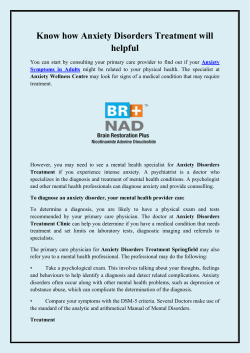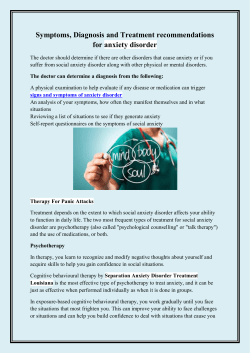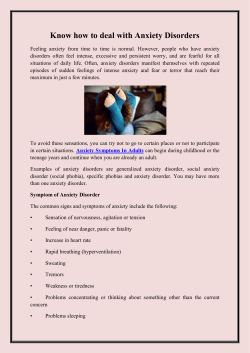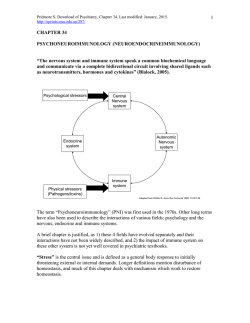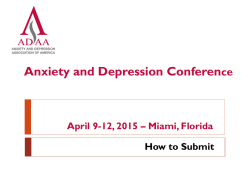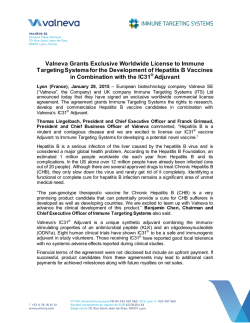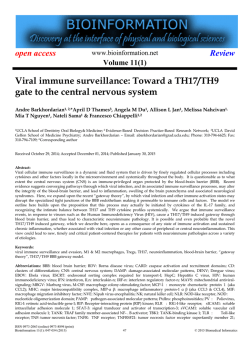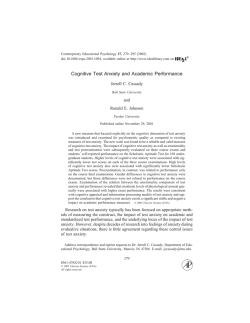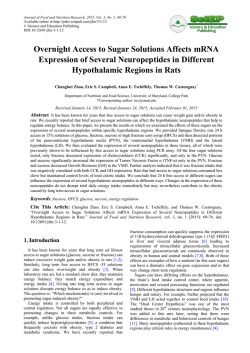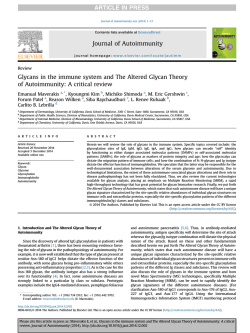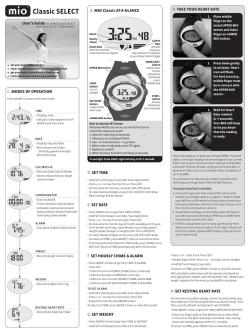
Full Text (PDF) - Science and Education Publishing
American Journal of Public Health Research, 2015, Vol. 3, No. 1, 15-20 Available online at http://pubs.sciepub.com/ajphr/3/1/3 © Science and Education Publishing DOI:10.12691/ajphr-3-1-3 Stress, a Major Determinant of Nutritional and Health Status Paulina Oludoyin ADENIYI* Institute of Agricultural Research and Training, Apata, Ibadan, Nigeria. University of Ibadan, Nigeria *Corresponding author: [email protected] Received January 06, 2015; Revised January 21, 2015; Accepted January 28, 2015 Abstract The continual desire to thrive against all odds even with the current global economic and other livelihood challenges coupled with various natural and man-made disasters has subjected humanity incessantly to physical, physiological and psychological stress traceable to different etiologic stressors. This has consequently resulted into increasing prevalence in stress and stress-related diseases worldwide. Hence, this paper reviews stress as it relates to appetite, digestion, nutrient metabolism, immunity and other diseases with a view of creating public awareness on this concept and the possible stress management techniques. The search engines used are HINARI, PubMED and Google Scholar. Stress can have both orexigenic and anorexigenic effect thus influencing appetite and food intake via the metabolic activities of glucocorticiods and Neuropeptide Y commonly produced during a fight-or-flight response to stress. Vagus nerve activation which occurs during stress directly and profoundly influences metabolic responses to food via altered digestion, absorption and metabolism of nutrients thus pre-disposing the body to malnutrition. Glucocorticoids may adversely affect immune system by suppressing the helper T-cells and overexpressing the T suppressor cells thus inhibiting the body’s defence mechanism against both infectious and noninfectious diseases. More still, glucocorticoids have been implicated in the pathogenesis of diabetes via increased hepatic blood glucose by increased gluconeogenesis and may exacerbate or inhibit tumorigenicity in cancer progression. Regular exercise, healthy diet, deep breath exercise, adequate sleep and limiting exposure to stressors if possible are generally effective in coping with stress and managing stress. Keywords: stress, nutritional status, health status Cite This Article: Paulina Oludoyin ADENIYI, “Stress, a Major Determinant of Nutritional and Health Status.” American Journal of Public Health Research, vol. 3, no. 1 (2015): 15-20. doi: 10.12691/ajphr-3-1-3. 1. Introduction Stress can be defined as a challenge, which may be positive or negative conditions, that distorts the metabolic homeostasis and alters the physical, physiological and psychological states of the body in the latter’s fight-orflight response to a stressor. It is a person’s physiological response to internal or external stimuli that triggers a fight-or-flight response in an attempt to restore the body’s homeostasis which has been distorted by stressor. There are different types of stressors which may predispose the body to stress. Some of these include: Physical stressor (intense exertion, manual labor, sleeplessness, travel) (Rider et al., 2014), Chemical stressors (drugs, alcohol, caffeine, nicotine, environmental pollutants such as cleaning chemicals, pesticides, herbicides) (Rider et al., 2014), mental stressors (perfection, worry, anxiety, long work hours) (Maina et al., 2008), emotional stressors (anger, guilt, loneliness, sadness, fear) (Dayas et al., 2008; Breivik et al., 2007), nutritional stressors(food allergies, vitamin and mineral deficiencies) (Kriengwatana et al., 2014; Fan et al., 2014), Traumatic stressors (injuries or burns, surgery, illness, infections, extensively high temperature) (Walsh et al., 2014), psycho-spiritual/ social (troubled relationships, financial or career pressure, challenges with life goals, spiritual alignment, unhappiness) (Siopen et al., 2012). All these stressors may subject the body to physical, physiological and psychological stress depending on the type of stressor and the severity of the effect on the individual. Response to these may be dictated by physiological, experiential and organismic variables or determinants. Human beings cannot but be subjected to some types of stressors which necessitates the understanding of the consequences on health and nutritional status as well as the enlightenment of the feasible ways of coping with stress. This paper hereby reviews the influence of stress on nutritional and health status and the possible stress management techniques. 1.1. Physiology of Stress The Central Nervous System (brain and spinal cord) in conjunction with the endocrine system play crucial and critical roles in the body/s response to a stressor. The hypothalamus is a small portion of the brain located below the thalamus and above the brainstem and it links the nervous and endocrine systems together. During a stress response the hypothalamus secretes corticotrophinreleasing hormones which stimulates the body’s pituitary 16 American Journal of Public Health Research gland and initiates a heavily regulated stress response pathway (O Connor et al., 2000). Amygdala which is situated bilaterally deep within the medial temporal lobes of the brain play vital roles in the processing of emotions by modulating stress response mechanisms particularly when feelings of anxiety or fear are involved (Roozendaal et al, 2009) while the Hippocampus which is situated just below each amygdala play important role in memory formation (Marsis and Barcim, 2012). During stress the hippocampus is particularly responsible for cognitive processes such as prior memories and it has great influence on enhancing, suppressing or even independently generating a stress response but it is highly susceptible to damage by chronic stress (McEwen, 2012). Another organ of interest in the regulation of cognitive processes is the prefrontal cortex. It is necessary for planning, attention and problem solving through extensive connections with other brain regions and can easily be impaired during a stress response. (McEwen and Morrison, 2013, Amsten 2009). The locus coeruleus is the principal site of the production of the neurotransmitter- nor epinephrine which plays an important role in the sympathetic nervous system’s fight-or-flight response to stress. This area receives signal in form of inputs from the hypothalamus, amygdala and raphe nucleus among other regions and projects widely the brain and spinal cord. Raphe nucleus is the principal site of the synthesis of the neuro-transmitter which is responsible for mood regulation especially when stress is associated with depression and anxiety. It also modulates circadian rhythm and sensation of pain. As earlier mentioned, the pituitary and adrenal glands also participate in the body’s response to stress. The spinal cord transfers stress response neural impulses from the brain to the rest of the body. It also stimulates peripheral nerves which consequently engage the body’s major organs and muscles in a fight-or-flight response to stress. The pituitary gland is a small organ located at the base of the brain just under the hypothalamus and it secretes hormones which are responsible for the regulation of homeostasis in the body. During a response this gland releases adrenocorticotropic hormone into the blood stream which modulates a heavily regulated stress response system. The adrenal gland is situated directly on top of the kidneys and is basically responsible for the synthesis of the stress hormone-cortisol (a glucocorticoid) and nor epinephrine (a neurotransmitter) into the blood stream during a stress response. All these co-operate in the fight-or-flight response to stress in order to restore the homeostasis thus altering the various body metabolism in the process. Cortisol is a steroid hormone belonging to the glucocorticoids and is responsible for the re-distribution of energy (glucose) to the regions of the body that need it most during stress (e.g. brain and major muscles). This inadvertently suppresses the immune system, increases blood glucose via increased gluconeogenesis and alters fat and protein metabolism (Janssen and Lambert, 2014). Cortisol is produced from cholesterol in the adrenal cortex Nor epinephrine secreted by locus-coeruleus upon stimulation by the hypothalamus is a primary chemical messenger of the CNS’s sympathetic branch that prepares the body for fight-or- flight response to stress (Flak et al., 2014). Serotonin is a neurotransmitter synthesized in the raphe nucleus of the pons of the brainstem and projects to most brain areas. It plays vital roles in mood regulation and stress-induced dysfunctions and has been reported to influence anxiety, fear and depression (Puglisi-Allegra and Andolina, 2015; Kim et al., 2014;) Neuropeptide Y which is a protein produced in the hypothalamus and acts as a chemical messenger in the brain is of vital concern because of the important roles it plays in regulation of appetite, feeding behavior, satiety and anxiety during stress. (Janice 2008). 1.2. Mechanism of Appetite Stimulation Appetite is controlled by many organs of the body including the brain, gut and adipose tissue. These are coordinated by the parasympathetic, sympathetic and other systems involving a wide variety of peptides and hormones. While some stimulate appetite (e.g. Ghrelin, neuropeptide, neuropeptide Y) others are inhibitors of appetite such as; glucagon-like peptide-1 (GLP-1), oxyntomodulin (OXM), pancreatic polypeptides (PP), peptide tyrosine tyrosine (PYY), Obestatin, cholecystokinin (CCK) and Amylin. These inhibitors of appetite are gut hormones which are secreted in a nutrientdense state resulting from foods digestion and nutrients’ absorption. The nutrients activate G-protein coupled receptors in the entero-endocrine cells (L-cells) and stimulate the release of the gut hormones earlier mentioned. Insulin and leptin are also hormones involved in the regulation of food intake. These are secreted in direct proportion to the body fat and later enter the CNS to reduce food intake Ghrelin on the other hand is the only anorexigenic molecule / peptide secreted from the gut (stomach, small intestine and colon), pancreas and hypothalamus; and plasma levels decreases after a meal thus producing satiety. It is stimulated in response to hunger and starvation to the CNS through the vagus nerve and causes over expression neuropeptide Y and AgRP (Nakazeto et al., 2001). Having identified the hormones and peptides involved in appetite stimulation it is imperative to understand how these are able to control the CNS with respect to food intake. The influence of these hormones and peptides on the activity of arcuate nucleus (ARC) of the hypothalamus (which contains two population of neurons with opposing effects on food intake (Parkingson et al., 2008); and the nucleus of the tractus solitaries (NTS) results in appetite regulation (Sam et al., 2012; Hang et al., 1998). Neural projections from the NTS carry signals to the hypothalamus. The ARC integrates and co-ordinates two major neurons involved in appetite regulation. These are : the orexigenic neurons which co-expresses neuropeptide Y (NPY) and agouti-related protein (AgRP) which increase appetite and food intake; and the anorexigenic neurons which co-expresses propiomelanocortin (POMC), cocaine and amphetamine-regulated transcripts (CART) that reduce appetite and food intake (Sam et al., 2012; Hang et al., 1998). AgRP opposes the effects of the POMC and CART product, α-melanocyte stimulating hormone (α-MSH). Both neurons project to areas which are important in the regulation of food intake such as hypothalamic paraventricular nucleus and hypothalamus (Crespo et al., 2014; Elias et al., 1998). American Journal of Public Health Research 1.3. Stress and Appetite Stimulation The influence of stress in appetite stimulation can be identified in the neuro-endocrine integration of the stress centers of the CNS and the centers responsible for appetite stimulation (Kyrou et al., 2006). Acute stress exerts an anorexigenic effect via the stimulation of POMC/ CART neurons by the increased Corticotropin-releasing factor (CRH) levels and a decrease in NPY secretion (Upton and Roley, 2013; Ortega et al., 2013; Krou et al., 2000). CRH activates the hypothalamus-pituitary adrenal axis with an increase in cortisol secretion which consequently inhibits the activation of the Hypothalamus-pituitary adrenal (HPA) axis. This exerts the anorexigenic effect of glucocorticoid secretion. On the other hand chronic stress often exerts orexigenic effect due to the chronic activation of HPA axis and prolonged glucocorticoid secretion. These inhibit CRH and stimulate NPY expression (Raspoppow, 2014; Krou et al., 2006; Chrousos, 2000). The HPA axis is one of the neuro-endocrine axes that play important roles in the regulation of stress-response by regulating the secretion of glucocorticoids (cortisol in humans and corticosterone in animals (Tsigel and Chrousos, 2002). Stress may result into either over-eating or under-eating depending on the nature of stress, stressor severity and individual pre-disposition (Torres and Noulson 2007). Life-threatening stress had been reported to reduce food intake while mild stress such as examination stress resulted in increased energy intake (Torres and Nowson, 2007) in humans. Increased secretion of glucocorticoids have been found to induce constipation in both human and animal studies (Bhatia and Tandon, 2005). 1.4. Stress and Immune System Activation of HPA axis and the sympathetic- adrenalmedullary axis results in chronic production of glucocorticoid hormone and catecholamines. Glucocorticoid receptors expressed on a variety of immune cells bind cortisol and interfere with the function of NF-αβ which regulates the activity of cytokineproducing immune cells. Adrenergic receptors bind epinephrine and non-epinephrine thus activating the c AMP response element-binding protein thus inducing the transcription of genes encoding a variety of cytokines. The changes in gene expression modulated by glucocorticoid hormones and catecholamines van dysregulate immune function (Padgett and Glaser, 2003). The lowering effect of stress on immune system has been established by various research findings. Anxiety lowered the body’s immune system thus increasing risks of health problems by the reduction of the production of helper-T cells which is a consequence of increased blood cortisol (Jarenka et al., 2013). Several studies have ascertained the adverse effect of glucocorticoids produced during stress on the immune system though it may also be beneficial. Stress-induced glucocorticoids may sensitize the CNS innate immune effectors (e.g. microglia) thereby triggering sickness response to infection or injury and maximizing the body’s ability to neutralize danger, hence acting as a neuroendocrine warning signal to the innate immune system in a fight-or-flight emergency (Frank et al., 2013). Acute stress improves natural immunity but suppresses specific immunity. Natural stressor (for instance examination) tend to suppress cellular but preserves 17 humoral immunity in human subjects (Segerstrom and Miller, 2004). Similarly, physiological stress such as prenatal restraint stress was reported to adversely modify immune homeostasis thus increasing vulnerability to infection and and disease. in adult female mice stress (Pascuan et al., 2014) while increased acute stress-induced corticosterone inhibited lymphocyte response to hormone in pregnant mice (Pascuan et al., 2014). Chronic stress was also reported to accelerate the natural ageing of the immune system (Bennett et al., 2013). 1.5. Stress and Diseases Stress has been associated with delay of healing of wounds via the suppression of the production of proinflammatory cytokines such as interleukin-6 (IL-6), IL-Ibeta (Iβ) and tumor necrosis factor alpha (TNF-α) by glucocorticoids which was produced by stress (Lin et al., 2014). This was evidenced by the findings of Padget et al that reported improved healing of wounds at a rate similar to non-stressed mice in stress mice with poor healing of wound when injected with glucocorticoid receptor antagonist (Padget et al., 1998). Psychological stress in human subjects was also observed to delay wound healing via similar mechanism in rodents. Glucocorticoids exerted inhibitory effect on the stress response by receptors located in the medial prefrontal cortex and hippocampus thus increasing intestinal permeability to large antigenic molecules, causing mast cell activation, degranulation, and colonic mucin depletion and inadvertently leading to ulcer (Bhatia and Tandon, 2005). More still, stress has been implicated in the pathogenesis of diabetes mellitus. Glucocorticoids have been reported to cause insulin resistance in skeletal muscles and liver by decreasing the transcription of insulin receptor substrate-1 (IRS-1) and increasing the transcription of the transcription of two proteins that inhibit insulin action: protein tyrosine phosphatase type 1B (PTP1B) and p38MAPK (Almon et al., 2007; Almon et al., 2005; Bazuline et al., 2004 ). Glucocorticoids also decreased IRS-1 and IRS-2 levels in fats (Buren, 2008; Saad et al., 1993) as well as the phosphorylation of IR and IRS-1in the liver (Bazuline et al., 2004; Saad et al., 1993). The role of stress in the initiation of cancer has been reported by past scientific findings. During chronic stress and depression there is persistent activation of hypothalamus-pituitary-adrenal axis (HPA) which impairs the immune response and contributes to the development of the progression of some types of cancer. This may be as a result of decreased cytotoxic T cells and natural killer cells activities that affect processes such as immune surveillance of tumors (Reiche et al., 2004; Sklor and Anisman, 1981). 1.6. Stress Management The need to manage stress or to cope with stress is of paramount importance in an individual’s day to day activities because we are exposed to varying degrees and types stressors daily.. Experts have identified feasible and effective stress management techniques follows: Progressive muscle relaxation; Autogenic training; Relaxation response; Guided imagery; Diaphragmatic breathing; Cognitive behavioral therapy and Mindfulness- 18 American Journal of Public Health Research based stress reduction. These are evidence-based, easy-tolearn and practice techniques which have yielded desireable results in both sick and healthy individuals. Progressive muscle relaxation (PMR) is a two step process. It involves systematically increasing tension in some particular muscles (such as neck, shoulder, arm etc) and releasing the tension. It is good to note how the muscles feel after releasing the tension. This exercise reduces overall body tension, stress and anxiety (Bracke 2010). It is a form of stress management via the reduction of muscle tension which concomitantly reduces central nervous system activity thus promoting a relaxed state. It involves holding skeletal muscles tight and inhaling for about 5 seconds then exhale as the muscles are released. This should be done for at least 15 minutes (Bracke, 2010). PMR has been reported to remarkably reduce anxiety, depression and overall stressed state in cancer patients (Potthoff et al., 2013), effective in reducing anxiety in healthy subjects (Lee et al., 2012) as well as schizophrenia and psychological stress in general (Vancampfort et al., 2013; Vancampfort et al., 2011). Autogenic training (AT) is a stress management technique to achieve deep relaxation. It involves getting into a simple posture ( such as lying down or sitting comfortably) and concentrating one’s mind on following a verbal or visual command doing some simple exercises to relax the body in specific ways. AT is used to relieve symptoms of stress such as anxiety, fatigue, irritability as well as to reduce pain, sleeping disorders and increase resistance to stress (Naglattzki et al., 2012; Shinozaki et al., 2010). Relaxation response (RR) is the personal ability of an individual to trigger the body to release hormones and brain signals that slows down the activity of muscles and organs and increase blood flow to the brain. It is a fight or flight response to stress. It helps to turn off the fight of flight response and bring the body back to the pre-stress state. Methods of RR include: visualization; progressive muscle relaxation; energy healing; massage; breathing techniques; prayer; meditation or avoidance of potential stressor if possible. Steps to elicit RR include; sitting quietly in a comfortable position, closing the eyes, relaxing the muscles, breathing through the nose and relaxing the tongue for thought to cease. Do not think about anything and do these for 10 to 20 minutes. Constant practice creates desired relaxation response. Guided imagery is a gentle but powerful technique the focuses and directs the imagination to positive image or events in order to reduce pains and stress. It is made effective through the power of positive thinking. It may also be called visualization and mental imagery. It seduces the mind with appealing sensory images which consequently relaxes both the mind and the body. This has been reported to be effecting in various stress related diseases (Verkaik et al., 2014; Rossman 2010). It results to increased inner peace and creative thinking, improved health, greater success and happiness. It unfolds the full potential of life for an individual. Diaphragmatic breathing is the breathing which is done by contracting the diaphragm. Air enters the lungs and the abdomen or belly expands and not the chest. It can also be called abdominal breathing, belly or deep breathing. It is a healthier way of breathing and is considered therapeutic in alternative medicine for the prevention and treatment of high blood pressure, anxiety, headaches, depression, stomach conditions and other stress-related ailments (Martarelli et al., 2011; Fernandes et al., 2011; Jefferson 2010). Cognitive Behavior Therapy (CBT) This involves an initial stage of self discovery and functional analysis during which an individual’s thoughts, feelings and response to situations are used to explain the maladaptive behavior of the individual. This is a very essential part of the treatment process. This is followed by focusing on the actual behavior that are contributing to the stressor or problem. The patient begins to learn and practice new skills that can then be put into use in real life situations for instance, a person suffering from drug addiction might start practicing new coping skills and rehearsing ways to avoid or deal with social situations that could potentially trigger a relapse. Lastly, the person will need to take definite steps towards a behavioral change, for instance, a person suffering from social anxiety might start by imagining himself in an anxiety-provoking social situation and later take actual steps into practicing conversation with friends, family, acquaintances and then to larger social settings (Andrews et al., 2011; Hawton et al., 1989). CBT is suitable for management of anxiety, phobia, depression and addiction (Granath et al., 2006). 2. Conclusion Even though man is continually subjected to different types of stressors in order meet up with the demands of survival, identification of the stressor(s) and the proper application of appropriate stress-reducing mechanism(s) would alleviate stress-induced occurrences with a concomitant improved quality of life and fulfillment. References [1] [2] [3] [4] [5] [6] [7] [8] [9] Almon R.R., Dubois D, Jim JY., Jusko W.F. (2005). Temporal profiling of the transcriptional basis for the development of corticosteroid-induced insulin resistance in rat muscle. J. Endocrimol.; 184 (1): 219-232. Almon RR.,DuBois D.C., and Jusko W.J. (2007). A micro array analysis of the temporal response of liver to methylprednisolone: a comparative analysis of two dosing regimens. Endocrinology; 148 (5): 2209-2225. Amsten A.M.T. 2009. Stress signaling pathways that impair prefrontal cortex structure and function. Nature; Reviews Neuroscience; 10 (6): 410-422. Andrews G., Davies M. and Titov N. (2011).Effectiveness of Randomized Controlled Trial of face to face versus internet Cognitive Behavior Therapy for social phobia. Australian and New Zealand Journal of Psychiatry; 45 (3): 337-340. Bazuline M.,Carlotti F., Tafrechi R.S.J., Hoeben R.C., Maassem J.A. (2004). Mitogen-activated protein kinase (MAPK) phosphatase-1 and -4 attenuate p38 MAPK during dexamethasone-induced insulin resistance in 3T3-L1 adipocyte. Mol. Endocrinol.; 18 (7): 1697-1707. Bennett J.M., Fagundes C.P. and Kiecolt-Glaser J.K. (2013). The chronic stress of care giving accelerates the natural ageing of the immune system. Immunosenescence. Bosch J.A. (eds). Pg 35-46. Springer Suremert Bussiness Media, New York. Bhatia V and Tandon R.K. (2005). Stress and the gastrointestinal tract. J. Gastroenterol. Hepatol.; 20 (3): 332-9. Bracke P.E. (2010). Progressive Muscle Relaxation. Corsini Encyclopedia of Psychology (1-2). Breivik T., Throne P.S.,Murison R and Gjermo P.(2007). Emotional stress effects on immunity, ginvitis and periodontitis. European Journal of Oral Science; 104: 327-334. American Journal of Public Health Research 19 [10] Buren J., Lai Y.C., Lundaren M., Eriksson J.W. and Jensen [31] Lin T-K., Man M-Q., Santiago J-L., Scharschmidt T.C., Hupe M., J.(2008). Insulin action and signaling in fat and muscle from dexamethasone-induced rats. Arch. Biochem Biophys.; 474 (1): 91-101. Chrousos G.P. (2000). The role of stress and the hypothalamicadrenal-axis in the pathogenesis of the metabolic syndrome, neuro-endocrine and target tissue-related causes. Int J. Obes. Relat. Metab. Disorder; 24: (Suppl 2): S50-5. Crespo C.S., Cachero P., Jimenez L.P., Barrios V and Ferreiroo E.A (2014). Peptides and food intake. Frontiers in Endocrinology; 5: 58-62. Dayas C.V., Buller K.M. and Day T.A. (2008). Neuroendocrine responses to an emotional stressor: evidence for involvement in the medial but not the central amygdale. European Journal of Neuroscience; 11 (7): 2312-2322. Elias C.F., Lee C., Kelly J., Aschkenasi C.,Ahima R.S.,Couceyro P.R., Kuhar M.J., Saper C.B. and Eimquest J.K. (1998). Leptin activates hypothalamic CART neurons projecting to the spinal cord. Neuron; 21 (6): 1375-85. Fan J.,Cui Y.,Wan M.,Wang W and Li Y. (2014). Lipid accumulation and biosynthesis genes response of the oleaginous Chlorella pyrenoidosa under three nutrition stressors. Biotechnology for Biofuels; 7: 17-30. Fernandes M., Cukier A and Feltrim M.I.Z. (2011). Efficacy of diaphragmatic breathing in patients with chronic obstructive pulmonary diseases. Chronic Respiratory Disease; 8 (4): 237-244. Flak J.N., Myers B., Solomon M.B.,McKlveen J.M.,Krause E.G. and Herman J.P. (2014). Role of paraventricular nucleusprojecting norepinephrine neurons in acute and chronic stress. European Journal of Neuroscience; 39 (11): 1903-1911. Frank G.M., Watkins L.R and Maier S.F. (2013). Stress-induced glucocorticoids as a neuro endocrine alarm signal of danger. Brain Behaviour and Immunity; 30: 1-6. Granath J., Ingvarsson S., von Thiele U and Lundberg U. (2006). Stress management: A randomized study of cognitive behavioral therapy and yoga, Cognitive Behavior Therapy; 35 (1): 3-10. Hahn T.M.., Breininger J.F., Baskin D.G and Schwartz M.W. (1998). Co-expression of Agrp and NPY in fasting-activated hypothalamic neurons.Nut. Neurosci.; 1 (4): 271-2. Hawton K.E.(Ed), Salkovskis P.M.(Ed).,Kirk J.E. (Ed) and Clark D.M. (Ed). (1989). Cognitive Behavior Therapy for psychiatric problems: A practical guide. Oxford University Press, New York, NY, U.S.A. Janice U (2008). Neuropeptide Y in the amygdale induces longterm resilience to stress-induced reductions in social responses but not hypothalamic-adrenal-pituitary axis activity or hypothalamus. The Journal of Neuroscience; 28 (4): 893-903. Janssen J.A.M.J.L and Lamberts S.W. (2014). Diabetes associated with glucocorticoid excess in Diabetes Secondary to endocrine and pancreatic disorders. Chigo E and porta M (eds) Front Diabetes Base; Volume 22: 22-23., Karger Publishers. Jaremka L.M., Glaser R.,Loving T.J.,Malawkey W.B., Stowell J.R and Kietcolt-Glaser J.K. (2013). Attachment anxiety is linked to alterations in cortisol production and cellular immunity. Psychological Science; 24 (3): 272-279. Jefferson L.L. (2010). Exploring effects of therapeutic massage and patient teaching in the practice of diaphragmatic breathing on blood pressure, stress and anxiety in hypertensive Africa-America women: an intervention study. Europe PubMed Central. www.europepmc.org/med/20857772 Kim B.S., Lee J., Bang M.,Seo B.A., Khalid A., Jung M.W. and Jeon D. (2014). Differential regulation of observational fear and neural oscillations by serotonin and dopamine in the mouse anterior cingulated cortex. Psychopharmacology; 231: 4371-4381. Kokot F and Ficek R. (1999). Effects of neuropeptide Y on appetite. Mineral Electrolyte Metabolism; 25(4-6): 303-5. Kriengwatana B.., Wada H., Schmidt K.L., Taves M.D.,Sama K.K. and MacDougall-Shackleton S.A. (2014). Effects of nutritional stress during different developmental periods and the hypothalamic-pituitary-adrenal-axis in zebra flinches. Hormones and Behavior; 65 (3): 285-293. Krou I., Chrousos G.P and Tsigos C (2006). Stress, visceral obesity and metabolic complications. Ann. New York Acad. Sci.; 1083: 77-110. Lee E.J., Bhattacharya J., Sohn C and Verres K.(2012). Monochord sounds and progressive muscle relaxation reduce anxiety and improve relaxation during chemotherapy: A pilot EEG study. Complementary Therapies in Medicine; 20 (6): 409-416. Martin-Ezquerra G., Youm J-K., Zhai Y., Trullas C., Feingold K.R. and Rlias P.M. (2014). Paradoxical benefits of psychosocial stress in inflammatory dermatoses models are glucocorticoid mediated. Journal of Investigative Dermatology; 134: 2890-2897. Maina G.,Palmas A and Day T.A.(2008). Relationship between self-reported mental stressors at the workplace and salivary cortisol. Int. Arch. Occup. Environ. Health; 81: 391-400 Marsis P.M. and Barcim T.Z. (2012). Sculpting the hippocampus from within stress, spines and CRH. Trends in Neuroscience; 35 (5): 315-324. Martarelli D., Cocchioni M., Sairi S and Pampei P. (2011). Diaphragmatic breathing reduces exercise-induced oxidative stress; Evidence-Based Complementary and Alternative Medicine; Vol 2011. McEwen B.S. (2012). Brain on stress: How the social environment gets under the skin. Proceedings of the National Academy of Science; 109 (Suppl 2): 17180-17185. McEwen B.S. and Morrison J.H. (2013). The brain on stress: Vulverability and plasticity of the prefrontal cortex over the life course. Neuron; 79 (1): 16-29. Naglatzki R.P., Schiamann M., Gasser T., Lado M.E., Sure U., Forsting M. and Gizewski E.R. (2012). Cerebral somatic pain modulation during autogenic training in IMRI. European Journal of Pain; 16 (9): 1293-1301. Nakazeto M., Murakami N., Date Y., Kojima M., Matsuo H., Kangawa K. and Matsukura S. (2001). A role for ghrelin in the central regulation of feeding. Nature; 469 (6817): 194-8. O Connor T.M., O’Hailoran D.J. and Sharaathan F (2000). The stress response and the hypothalamic pituitary adrenal axis: from molecule to melancholia. QJM monthly Journal of the Association of Physicians; 93 (6): 323-333. Ortega V.A., Lovepy D.A and Bernier N.J. (2013). Appetite suppressing effects and interactions of centrally administered corticotrophin-releasing factor, urotensin I and serotonin in rainbow trout (Oncorhynchus mykiss). Frontiers in Neuroscience; 7: 196. Padgett D.A and Glaser R (2003). How stress influences the immune response. Trends in Immunology; 24 (8): 444-448. Parkinson JR., Ohillo W.S.,Small C.J., Chavdlin O.B., Bewick G.A., Pritchard I.,Moore S., Ghate M.A., and Bloom S.R., (2008). PYY 3-36 injection in mice produces an acute anorexigenic effect followed by a delayed orexigenic effect not observed with other anorexigenic gut hormones. Am J. Physiol. Endocrinol. Metab. 294 (4): 698-708. Pascuan C.G., Rubistein M.R., Palumbo M.L. and Genaro A.M. (2014). Prenatal stress induces up regulation of glucocorticoid receptors in lymphoid cells modifying the T cell response after acute stress exposure in the adult life. Physiology and Behaviuor; 126 (10): 141-147. Potthoff K., Schmidt M.E., Wiskemam J., Hof H., Klassen O., Habermann N., Beckhove P., Debris J., Ulrich C.M and Steindorf K (2013). Randomized controlled trial to evaluate the effects of progressive risitance training compared to progressive muscle relaxation in breast cancer patients undergoing adjuvant radiotherapy: the BEST study. BMC Cancer; 13: 162. Puglisi-Allegra S. and Andolina D. (2015). Serotonin and stress coping. Behavioral Brain Research; 277: 58-67. Raspopow K., Abizaid A., Matheson K and Anisman H. (2014). Anticipation of a psychosocial stressor differentially influences ghrelin, cortisol and food intake among emotional and nonemotional eaters. Appetite: 74: 35-43. Reiche E.M.V., Numes S.O.V. and Morimoto H.K. (2004). Stress, depression, the immune system and cancer. THE LANCET Oncology; 5 (10): 617-625. Rider C.V., Boekelheide K., Catlin N., Cardon C.J.,Morata T, Selgrade M.K., Sexton K. and Simmons J.E. (2014). Cummulative Risk: Toxicity and Interactions of physical and chemical stressors; Toxicology Science; 137:3-11. Roozendaal B., McEwen M.S. and Charttarji S. (2009). Stress, memory and the amygdale. Nature Reviews Heuroscience; 10 (6): 423-433. Rossman M.L (2010). ED Kramer HT. Guided imagery for self healing. New World Library, California, U.S.A. Saad M.J., Folli F., Kahn J.A. and Kahn C.R. (1993). Modulation of insulin receptor, insulin receptor substrate-1 and phosphatidylinositol 3 kinase in liver and muscle of dexamethasone-treated rats. J. Clin. Invest.; 92 (4): 2083-2072. [11] [12] [13] [14] [15] [16] [17] [18] [19] [20] [21] [22] [23] [24] [25] [26] [27] [28] [29] [30] [32] [33] [34] [35] [36] [37] [38] [39] [40] [41] [42] [43] [44] [45] [46] [47] [48] [49] [50] [51] 20 American Journal of Public Health Research [52] Sam A.H.., Troke R.C.., Tan T.M., and Bowok G.A. (2012). The [60] Vancampfort D., Correl C.U., Scheewe T.W., Probst M., De Herdt role of the gut/brain axis in modulating food intake. Neuropharmacology; 63 (1): 46-56. Segerstrom S.C. and Miller G.E. (2004). Psychological stress and the human immune system: a meta- analytic study of 30 years of inquiry. Psychological Bulletin; 130 (4): 601-630. Shinozaki M., Kanazawa M., Kano M., Endo Y., Nakaya N., Bongo M and Fukudo S. (2010). Effect of autogenic training on general improvement in patients with irritable bowel syndrome : a randomized controlled trial. Applied Psychophysiol. And Biofeedback; 39: 180-198. Siopen N.,Duettetra L.M., Williams D.R., Mujahid M.S., Lewis T.T., Bennett C.G., Ryff C.D. and Albert M.A. (2012). Psychosocial stressors and cigarette smoking among African American adults in midlife. Nicotine and Tobacco Research; 14 (10): 1161-1169. Sklor L.S. and Anisman H. (1981) Stress and Cancer. Psychological Bulletin; 78 (3); 389-406. Torres S.T. and Nowson C.A. (2007). Relationship between stress, eating behavior and obesity. Nutrition; 23 (11-12): 887-94. Tsigel C and Chrousous G.P. (2002). Hypothalamic-pituitaryadrenal-axis, neuro endocrine factors and stress. J. Psychosom. Res.; 53 (4): 865-71. Upton K.R and Roley L.G. (2013). Acute stress inhibits food intake and alters ghrelin signaling in the brain of tilapia (Oreochromis mossambicus). Domestic Animal Endocrinology; 44(3): 157-164. A., Krapen J and DeHert M. (2013). Progressive muscle relaxation in persons with schizophrenia: a systematic review of randomized control trials. Clinica; Rehabilitation; 27 (4): 291-298. Vancampfort D., DeHert M., Knapen J., Maurissen K.,., Roaepsaet J., Deckx S., Remans S and Probst M(2011). Effects of progressive muscle relaxation on state anxiety and subjective wellbeing in people with schizophrenia: a randomized controlled trial. Clinical Rehabilitation; 25 (6): 567-575. Veal D., Anson M., Miles M., Costa A and Ellison N. (2014). Efficacy of cognitive behavior therapy versus anxiety management for body dysmorphic disorders: a randomized controlled trial. Psychotherapy and Psychosomatics; 83 (6): 341-353. Verkark R., Busch M., Koenerman T.,van der Berg R., Spreeuwenberg P. and Francke A.L. (2014). Guided imagery in people with fibromyalgia: A randomized controlled trial of effects on pain, functional status and self efficacy. Journal of Health Psychology; 19 (5): 678-688. Walsh K., Elliot J.C., Shmulewitz D., Aharonovich E., Strous R., Frisch A., Wereman A., Spivak B., Grout B.F and Hasin D (2014). Trauma exposure, post trauma stress disorder and risk for alcohol, nicotine and marijuana dependence in Israel. Comprehensive Psychiatry; 55 (3): 621-630. Young J.B., Flatt J.P. and Ravussin E. (1996). Effects of glucocorticoids on energy metabolism and food intake in humans. Am. J. Physiol.; 27 (2): E317-25. [53] [54] [55] [56] [57] [58] [59] [61] [62] [63] [64] [65]
© Copyright 2026
